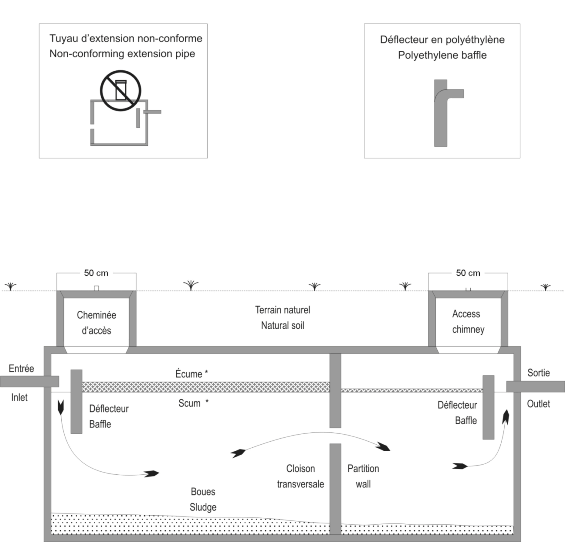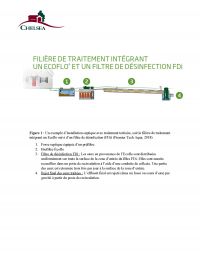A conventional septic system is composed of a septic tank and a leaching bed. A septic system treats your sewage right in your own yard and releases the treated effluent back into the groundwater.
Septic tank emptying program
The Municipality of Chelsea empties and inspects all residential septic tanks on its territory once every two years as part of its septic tank emptying program.
When you receive a notice at your door mentioning the week your septic tank will be pumped out, you must prepare the septic tank and if the lids are buried, you must uncover the two original septic tank lids.
Please note that if your septic system consists of a grey water tank and a holding tank, both will be emptied. We will not pump septic tanks with extension pipes.
A municipal employee will accompany the contractor when inspecting your system and will hand you an inspection report.
Start: May 5, 2025
End: October 10, 2025
Delay Recovery: Weeks of October 13 to 17, 2025
We invite you to consult the calendar to get an approximate idea of when your septic tank will be emptied.
Applying for a permit
You must apply for a permit before any work can begin to install a septic tank on the Municipality of Chelsea's territory. This is required for the construction of a complete septic system and for any partial work, such as the installation of a holding tank, replacement of a septic tank, and corrective measures for an existing leaching field.
NEW — Residents can now apply for the septic system via Pivot, votre espace citoyen.
Requesting information on your septic system and your well
You must complete the application form, Request for Information on a Septic Installation and email it to septique@chelsea.ca. An invoice will then be sent to you, by email, to pay the $50 fee. Payment can be made either by mailing a cheque (payable to: Municipality of Chelsea), by dropping it in the outside mailbox (we ask that you do not drop cash in the mailbox) or by coming to the Municipality of Chelsea. In the latter case, you can pay by cheque, debit or cash. The owner's signature is required except in cases where a notary was commissioned and making the request. In this case, the notary’s office will be charged. The letter sets out information available on file about your septic system and the results of the last inspection made under the Septic Tank Emptying Program offered by the Municipality. It should be noted that the inspection carried out under this Program is a visual inspection only.
We understand that these types of letters are required rapidly in real estate transactions, nevertheless, please allow 10 business days for the issuance of this document.
We recommend you have it inspected by a consultant specialized in sanitary engineering. We would like to point out that the Municipality of Chelsea cannot guarantee the compliance, longevity and proper functioning of the septic system.
Any other type of information about your septic system or well (i.e., a copy of the site plan, etc.)
We ask that you send your request at septique@chelsea.ca. A delay of approximately 10 business days should be expected to process the request.
Septic system with tertiary treatments and relase into the environment
In Chelsea, various types of septic systems may be installed on the territory depending on the topography, land dimensions and soil composition.
Sometimes, conventional systems and advanced secondary systems cannot be installed because:
- the soil composition is high in clay
- there is rock near the surface
- underground water sources are not very deep
- the slope is too steep
- the land surface is restricted, as ascertained by a technologist.
In such a case, the Ministère de l’environnement et de la lutte contre les changements climatiques du Québec (MELCC) allows systems with a tertiary treatment. The most common tertiary system is the treatment procedure with an Ecoflo® Biofilter and an FDi disinfection filter. Some systems with the Roseau épurateur also fall into this category.
Click on the image for an example of a septic system with tertiary treatment and release into the environment.
In Chelsea, strict environmental monitoring of septic systems with tertiary treatments that release waste water into the environment is ensured by the municipality to comply with prevailing regulations. These regulations set out the sampling calendar, pricing and environmental standards that must be respected.
Sampling and analysis fees may be integrated with the property taxes on a building. The municipality ensures compliance with the provincial Q-2, r. 22 Regulation respecting waste water disposal systems for isolated dwellings where environmental standards are out of line and initiates procedures with residents, if required (stopping use, repairs, etc.).
A third-party company is commissioned by the municipality to sample the effluent from these systems according to a sampling calendar established in By-law No. 768-10 (link) and the provincial compliance level for fecal coliforms is 200 UFC/100 ml at the point of sampling.
The level is over the limit if the concentration in two samples taken within a 60-day period exceed the provincial standard (fecal coliforms: 200 UFC/100 ml).
If the discharge standards are exceeded, the owner must temporarily seal the septic tank and seek the advice of his or her consultant to correct the system within the time frame established by the officer in charge.
In addition, when the discharge standards are exceeded, the sampling calendar will be downgraded to year 1.
Use of a tertiary treatment system with UV disinfection when replacing an existing septic system
Bylaw (1155-20) recognize tertiary treatment systems with UV disinfection as acceptable for the replacement of existing septic systems.
This solution is necessary for properties on which a septic tank is the only option. Holding tanks receive the wastewater from sinks, showers, and toilets and need to be emptied frequently, sometimes every two weeks.
This system is only to be used as a last resort, once it has been demonstrated that no other wastewater treatment mechanism or system can be installed on the property.
A tertiary septic system is a system that uses a UV lamp to treat wastewater from an advanced secondary treatment system. The wastewater goes into the septic tank, passes through the advanced secondary treatment system (e.g., Bionest, Enviro, Septic, Ecoflo), is treated by UV lamp, and is discharged into the environment.

1. Septic tank equipped with a primary filter. The wastewater goes to a septic tank where solids are separated from the liquid.
2. Ecoflo Biofilter. Treats water coming from the septic tank.
3. Pumping station. Integrated in Ecoflo’s polyethylene and concrete models.
4. Self-cleaning DiUV unit. Water moves at a constant, controlled speed in a quartz sleeve to optimize the exposure of pathogens to UV rays and ensure maximum deactivation.
5. Discharge of treated water. Treated water is discharged in accordance with Bylaw Q-2, r.22.
- It must be a replacement for an existing septic system.
- The owner must sign a commitment regarding compliance with the conditions set out in the by-law.
- The Municipality must have concluded a maintenance contract with the company.
- It must be demonstrated that no other septic system can be installed on the lot.
- The system must be installed by a qualified contractor in accordance with the manufacturer's instructions.
In accordance with the requirements of provincial by-law Q-2, r.22, Regulation respecting wastewater disposal systems for isolated dwellings, maintenance of tertiary treatment systems with ultraviolet radiation disinfection is carried out by the Municipality.
The Municipality therefore signs a contract with the company authorized to carry out maintenance on the system, and that company performs the maintenance and inspection.
The maintenance contract is charged to the Municipality by the company. The fees are then added to the annual tax bill for the property. The fees are considered a property tax.
This system uses a UV lamp to treat wastewater. When the bulb burns out and/or isn’t working, an alarm goes off in the owner’s home. If the alarm is ignored, the environmental risk goes up since discharged water won’t have been treated.
Since the Municipality doesn’t have any control over such situations, it limits the use of these system to “last resort” situations to reduce any environmental risk.
Learn more
The septic tank retains the solid portion of household wastewater and begins its decomposition. Heavier solids settle out of the wastewater and accumulate on the bottom of the septic tank as sludge. Lighter solids float to the surface and accumulate as scum.

The Leaching Bed
Liquid wastewater leaving the septic tank is directed towards the leaching bed. Wastewater is filtered through the ground and treated naturally by the decomposing action of bacteria and micro-organisms living underground.
The Septic Tank Pump-Out
Over time, the sludge will build up in the bottom of the septic tank. If the sludge is allowed to accumulate it will eventually flow into the leaching bed and rapidly clog the distribution pipes. Once the pipes become clogged, the wastewater will either seep to the surface of the ground or worse yet, back up into your house. Not only can a clogged septic system be hazardous to the environment and to your family’s health, it also represents a very expensive repair bill.
Effluent Filters
If your septic tank has a effluent filter, it must be cleaned once or twice every year to prevent clogging. Simply remove the filter and rinse it with a garden hose over the solid side of your septic tank.
Please note that, since January 2009 in the province of Québec, every prefabricated septic tanks must comply with BNQ (Bureau de Normalisation du Québec) standard 3680-905, and be equipped with an effluent filter at the outlet.
Information
Planning and Sustainable Development Department
This page was last updated on October 1, 2025



